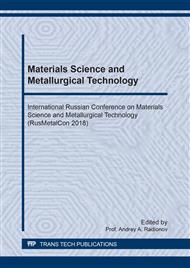[1]
S.V. Balikov, V.Е. Dementev, Gold Concentrates Melting, Irkutsk: Irgiredmet, (2002).
Google Scholar
[2]
B.V. Kolmogortsev, А.А. Varenichev, Technology for treatment of lean and refractory gold ores using dead roasting, Mining Information and Analytics Bulletin. 2 (2016) 204-218.
Google Scholar
[3]
Ya.М. Shneerson, М.Т. Zhunusov, L.V. Chugaev, А.V. Markelov, S.V. Drozdov, Complex technology for gold concentrates processing: BIOX and autoclave full oxidation, Nonferrous metals and minerals – 2012: Publications of the IV International Congress (Krasnoyarsk, 5-7 September of 2012). Krasnoyarsk, (2012) 576–583.
Google Scholar
[4]
V.V. Zhmurova, Developing a way of production of noble metal alloy with minimum residual element content, Nonferrous metals – 2010: Abstracts of II International Congress (Krasnoyarsk, 2-4 September of 2010). Krasnoyarsk, (2010) 325-332.
Google Scholar
[5]
Е.I. Ivanov, V.K. Sovmen, A way of extracting gold from refractory gold ores, Russian Patent no. 2275437.
Google Scholar
[6]
Information on: https://science.education.ru/ru/article/view=15619.
Google Scholar
[7]
V.S. Chekushin, Н.В. Oleynikova, Т.Т. Artykov, М.V. Chekushin, Modernising the refractory gold concentrates processing, Nonferrous metals and minerals – 2014: Publications of the V International Congress (Krasnoyarsk, 15-18 September of 2014). Krasnoyarsk, (2014) 741-746.
Google Scholar
[8]
E.A. Agorhom, W. Skinner, M. Zanin, Influence of gold mineralogy on its flotation recovery in a porphyry copper-gold ore, Chemical Engineering Science. 99(9) (2013) 127-138.
DOI: 10.1016/j.ces.2013.05.037
Google Scholar
[9]
L. Canda, T. Heput, E. Ardelean, Methods for recovering precious metals from industrial waste, IOP Conference Series: Materials Science and Engineering. 106(1) (2016) 12-20.
DOI: 10.1088/1757-899x/106/1/012020
Google Scholar
[10]
A.M. Hussin, Ahmed, Ayman A. El-Midany, Statistical optimization of gold recovery from difficult leachable sulphide minerals using bacteria, Materials Testing. 54(5) (2012) 351-357.
DOI: 10.3139/120.110339
Google Scholar
[11]
J.H. Kyle, P.L. Breuer, K.G. Bunney, R. Pleysier, Review of trace toxic elements (Pb, Cd, Hg, As, Sb, Bi, Se, Te) and their deportment in gold processing: Part II: Deportment in gold ore processing by cyanidation, Hydrometallurgy. 111-112 (2012) 10-21.
DOI: 10.1016/j.hydromet.2011.09.005
Google Scholar
[12]
S. Mohammadnejad, J.L. Provis, S.J. Van Deventez, The effect of grinding on the preg-robbing of gold quartz, International Journal of Mineral Processing. 128 (2014) 1-5.
DOI: 10.1016/j.minpro.2014.02.002
Google Scholar
[13]
S. Syed, Recovery of gold from secondary sources – A review, Hydrometallurgy. 115-116 (2012) 30-51.
DOI: 10.1016/j.hydromet.2011.12.012
Google Scholar
[14]
J. Tremolada, R. Dzioba, A. Bernardo-Sanchez, J.M. Menendez-Agnado, The preg-robbing of gold and silver by clays during cyanidation under agitation and heap leaching conditions, International Journal of Mineral Processing. 94 (2010) 67-71.
DOI: 10.1016/j.minpro.2009.12.001
Google Scholar
[15]
V.V. Zhmurova, А.I. Karpukhin, Research into the refinement of cathode deposits, resulting from gold-bearing polymetallic stock processing, Nonferrous metals. 9 (2012) 37-40.
Google Scholar
[16]
Е.I. Korotkova, Planning and organizing an experiment: textbook, Tomsk: Tomsk Polytechnic University Publishing House, (2010).
Google Scholar
[17]
Yu.P. Adler, Е.V. Markova, Yu.А. Granovsky, Planning an experiment searching for optimum conditions, Мoscow: Nauka, (1971).
Google Scholar
[18]
V.V. Zhmurova, N.V. Nemchinova, G.G. Mineev, Acid leaching of gold-bearing cathode deposit residual elements, Nonferrous metals. 7 (2017) 41-46.
Google Scholar
[19]
А.I. Karpukhin, Acid-and-salt gold and seilver refining: monograph, Irkutsk: Irgiredmet, (2003).
Google Scholar
[20]
G.G. Mineev, А.F. Panchenko, Gold and silver dissolving agents in hydrometallurgy, Мoscow: Metallurgiya, (1994).
Google Scholar


